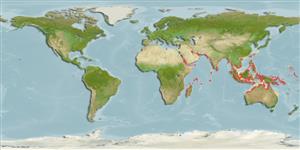Ikan bertulang rawan (sharks and rays) >
Myliobatiformes (Stingrays) >
Dasyatidae (Stingrays) > Urogymninae
Etymology: Pateobatis: Combination of Latin 'pateo' for 'lie open, be exposed' and 'batis' for skate, ray or flatfish; referring to the eclectic nature of members of this group.
Eponymy: Dr Pieter Bleeker (1819–1878) was an ichthyologist and army surgeon commissioned (1841) by the Dutch East India Company. [...] (Ref. 128868), visit book page.
More on author: Blyth.
Issue
Former synonym of Pateobatis uarnacoides (both previously under Himantura), but was resurrected as valid species (Ref. 114953).
Environment: milieu / climate zone / depth range / distribution range
Ekologi
laut; payau bentopelagis; amphidromus (Ref. 51243); kisaran kedalaman ? - 30 m (Ref. 9840). Tropical
Northern Indian Ocean: Pakistan to Myanmar (but range needs refinement).
Size / Weight / umur
Maturity: Lm ? range ? - ? cm
Max length : 84.0 cm WD jantan/; (Ref. 121648); 112.0 cm WD (female); Berat maksimum terpublikasi: 21.1 kg (Ref. 121648); Berat maksimum terpublikasi: 21.1 kg
Enters estuaries (Ref. 4832). Found mainly on muddy bottoms to at least 40 m depth. Most likely to feed on small crustaceans (Ref. 114953). Ovoviviparous (Ref. 50449). Feeds on bottom-living invertebrates (Ref. 68964).
Life cycle and mating behavior
Kematangan | Reproduksi, perkembang biakan | Pemijahan | telur-telur | Fecundity | Larva
Exhibit ovoviparity (aplacental viviparity), with embryos feeding initially on yolk, then receiving additional nourishment from the mother by indirect absorption of uterine fluid enriched with mucus, fat or protein through specialised structures (Ref. 50449). Distinct pairing with embrace (Ref. 205).
Talwar, P.K. and A.G. Jhingran, 1991. Inland fishes of India and adjacent countries. vol 1. A.A. Balkema, Rotterdam. i-liv + 1-541, 1 map (Ref. 4832)
Status IUCN Red List (Ref. 130435: Version 2024-1)
ancaman kepada manusia
Venomous
penggunaan manusia
Perikanan: komersial
Alat, peralatan
laporan khas
muat turun XML
Sumber internet
Estimates based on models
Preferred temperature (Ref.
123201): 26.6 - 29.3, mean 28.6 °C (based on 2266 cells).
Phylogenetic diversity index (Ref.
82804): PD
50 = 0.5312 [Uniqueness, from 0.5 = low to 2.0 = high].
Bayesian length-weight: a=0.01023 (0.00486 - 0.02155), b=3.06 (2.87 - 3.25), in cm total length, based on LWR estimates for this (Sub)family-body shape (Ref.
93245).
Trophic level (Ref.
69278): 3.5 ±0.5 se; based on size and trophs of closest relatives
Daya lenting (Ref.
120179): Rendah, Waktu penggandaan populasi minimum 4.5 - 14 tahun (Assuming fecundity<100).
Fishing Vulnerability (Ref.
59153): Very high vulnerability (90 of 100).
